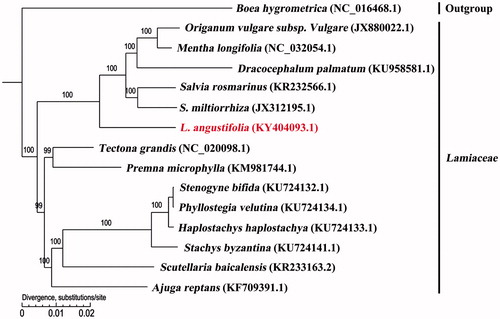Figures & data
Figure 1. Molecular phylogeny of L. angustifolia and other 13 related species in Lamiaceae rooted by Boea hygrometrica based on plastome sequence data. The complete chloroplast genome is downloaded from NCBI database and the phylogenic tree is constructed by MEGA6 software. The gene’s accession number for tree construction is listed as follows: Boea hygrometrica (NC_016468.1), Origanum vulgare subsp. Vulgare (JX880022.1), Mentha longifolia (NC_032054.1), Dracocephalum palmatum (KU958581.1), Salvia rosmarinus (KR232566.1), S. miltiorrhiza (JX312195.1), L. angustifolia (KY404093.1), Tectona grandis (NC_020098.1), Premna microphylla (KM981744.1), Stenogyne bifida (KU724132.1), Phyllostegia velutina (KU724134.1), Haplostachys haplostachya (KU724133.1), Stachys byzantina (KU724141.1), Scutellaria baicalensis (KR233163.2), and Ajuga reptans (KF709391.1). Lavandula angustifolia is labelled with red bold in the study. Bootstrap values are shown as percentages.

